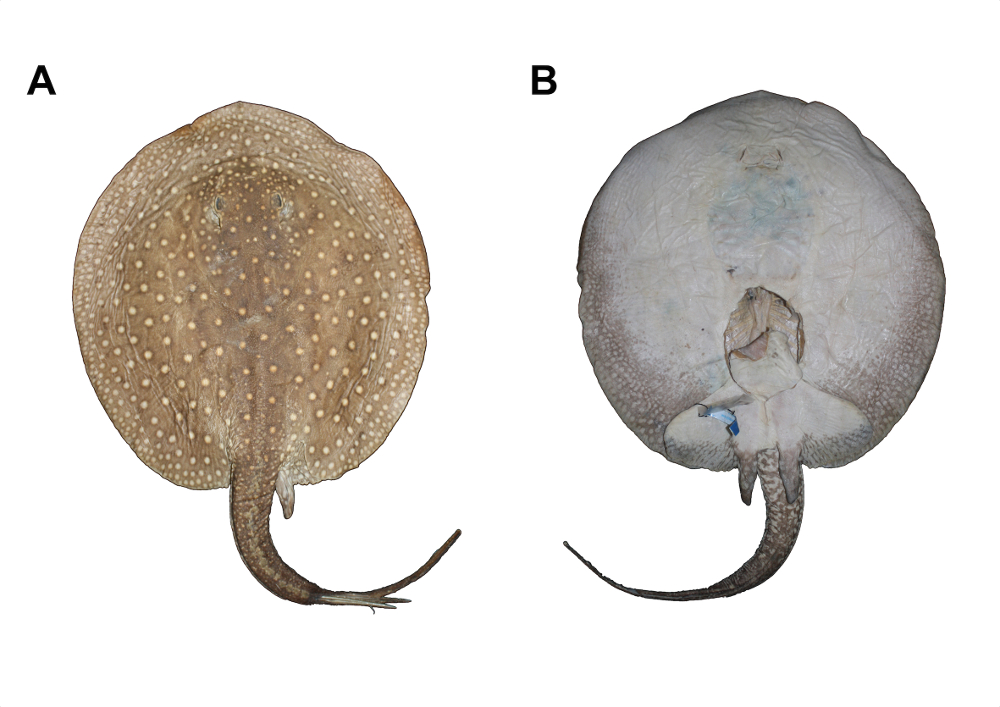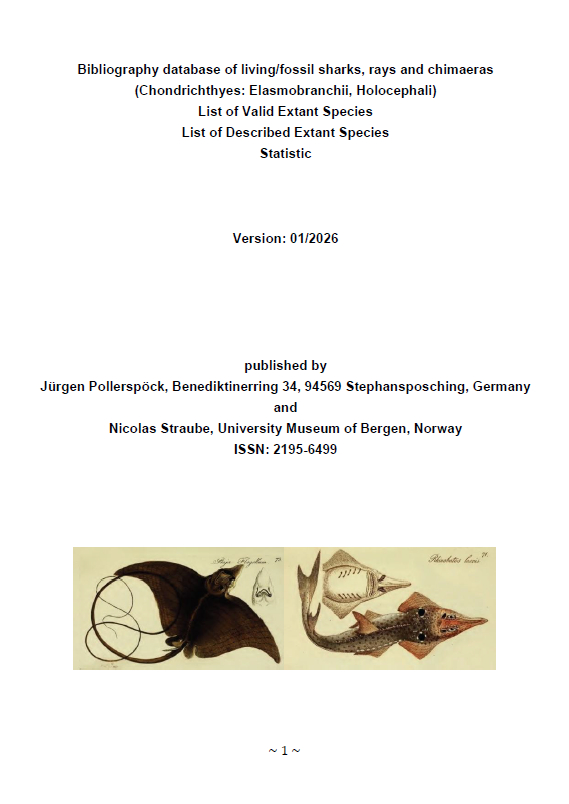Potamotrygon garmani
Fontenelle & De Carvalho, 2017
Classification: Elasmobranchii Myliobatiformes Potamotrygonidae
Reference of the original description
Systematic revision of the Potamotrygon scobina Garman, 1913 species-complex (Chondrichthyes: Myliobatiformes: Potamotrygonidae), with the description of three new freshwater stingray species from Brazil and comments on their distribution and biogeography. Zootaxa, 4310(1), 1–63
Systematic revision of the Potamotrygon scobina Garman, 1913 species-complex (Chondrichthyes: Myliobatiformes: Potamotrygonidae), with the description of three new freshwater stingray species from Brazil and comments on their distribution and biogeography. Zootaxa, 4310(1), 1–63
Description :
Citation: Potamotrygon garmani Fontenelle & De Carvalho, 2017: In: Database of modern sharks, rays and chimaeras, www.shark-references.com, World Wide Web electronic publication, Version 01/2026
Please send your images of "Potamotrygon garmani" to info@shark-references.com

Potamotrygon garmani Fontenelle & De Carvalho, 2017, Holotype, UNT 2174, adult? male, 341 mm DW, rio Paranã, rio Tocantins basin, state of Tocantins, Brazil © João Pedro Fontenelle

Potamotrygon garmani Fontenelle & De Carvalho, 2017, Holotype, UNT 2174, adult? male, 341 mm DW, rio Paranã, rio Tocantins basin, state of Tocantins, Brazil © João Pedro Fontenelle
Common names
 Garman's freshwater stingray
Garman's freshwater stingray
 Garman's freshwater stingray
Garman's freshwater stingray
Short Description
Original diagnosis after FONTENELLE & DE CARVALHO, 2017 [25646]: Potamotrygon garmani sp. nov. is distinguished from congeners, except P. limai, P. scobina, P. amazona and P. adamastor, by a combination of characters: disc dorsoventrally slender, with a light to dark brown dorsal color, and ocelli with beige, light yellow and whitish centers and a dark brown contour; ocelli mostly similar in size throughout disc but smaller ocelli sometimes present; small dermal denticles on central disc; disc margins usually without denticles; rostral denticles simple, with a single central cusp and a star-shaped basal plate; head denticles present star-shaped crowns, with one anterior and one posterior dichotomy lateral to the central cusp; caudal denticles present a central coronal plate and one anterior dichotomy; a third angular cartilage present; one or two irregular rows of thorns on dorsal tail midline, converging to a single row posteriorly; tail long and thin, with its base somewhat narrow; cartilaginous rod long, about same length as anterior portion of tail. Potamotrygon garmani sp. nov. is separated from P. limai by not having a reticulate or polygonal pattern on disc, by having a longer tail (100.6% DW vs. 86.3% in P. limai), and by having dermal denticles with fewer dichotomies and ridges. From P. amazona and P. adamastor by having a more slender disc, with less-developed disc musculature, smaller and fewer dermal denticles, greater and more defined ocellated spots on disc, and a more slender and longer tail (mean tail width 14.1% DW vs. 19.0% DW in P. adamastor and 16.7% DW in P. amazona; mean tail length 100.6% DW vs. 78.1% DW in P. adamastor and 89.3% DW in P. amazona). Finally, P. garmani sp. nov. is distinguished from P. scobina by presenting a brown disc, by having larger ocellated spots, tail shorter and wider (mean tail length 100.6% DW vs. 121.5% DW in P. scobina; mean tail width 14.1% DW vs. 13.4% DW in P. scobina), fewer teeth on both jaws (32–40/33–40 vs. 44/48–50 in P. scobina), and more thorns in dorsal mid-tail rows.
Original diagnosis after FONTENELLE & DE CARVALHO, 2017 [25646]: Potamotrygon garmani sp. nov. is distinguished from congeners, except P. limai, P. scobina, P. amazona and P. adamastor, by a combination of characters: disc dorsoventrally slender, with a light to dark brown dorsal color, and ocelli with beige, light yellow and whitish centers and a dark brown contour; ocelli mostly similar in size throughout disc but smaller ocelli sometimes present; small dermal denticles on central disc; disc margins usually without denticles; rostral denticles simple, with a single central cusp and a star-shaped basal plate; head denticles present star-shaped crowns, with one anterior and one posterior dichotomy lateral to the central cusp; caudal denticles present a central coronal plate and one anterior dichotomy; a third angular cartilage present; one or two irregular rows of thorns on dorsal tail midline, converging to a single row posteriorly; tail long and thin, with its base somewhat narrow; cartilaginous rod long, about same length as anterior portion of tail. Potamotrygon garmani sp. nov. is separated from P. limai by not having a reticulate or polygonal pattern on disc, by having a longer tail (100.6% DW vs. 86.3% in P. limai), and by having dermal denticles with fewer dichotomies and ridges. From P. amazona and P. adamastor by having a more slender disc, with less-developed disc musculature, smaller and fewer dermal denticles, greater and more defined ocellated spots on disc, and a more slender and longer tail (mean tail width 14.1% DW vs. 19.0% DW in P. adamastor and 16.7% DW in P. amazona; mean tail length 100.6% DW vs. 78.1% DW in P. adamastor and 89.3% DW in P. amazona). Finally, P. garmani sp. nov. is distinguished from P. scobina by presenting a brown disc, by having larger ocellated spots, tail shorter and wider (mean tail length 100.6% DW vs. 121.5% DW in P. scobina; mean tail width 14.1% DW vs. 13.4% DW in P. scobina), fewer teeth on both jaws (32–40/33–40 vs. 44/48–50 in P. scobina), and more thorns in dorsal mid-tail rows.
Dentition
Teeth small, simple and rounded, wider than long, set in quincunx, in a narrow arched upper tooth plate and a wide and trapezoidal lower tooth plate. Tooth rows varying from 32–40 in upper jaw and 33–40 in lower jaw. Adult males present a single central pointed cusp on central teeth of both jaws. Lateral teeth in adult males, teeth in juvenile males, and teeth in females simple, presenting a single rounded cusp. All teeth present a single cutting surface. [25646]
Teeth small, simple and rounded, wider than long, set in quincunx, in a narrow arched upper tooth plate and a wide and trapezoidal lower tooth plate. Tooth rows varying from 32–40 in upper jaw and 33–40 in lower jaw. Adult males present a single central pointed cusp on central teeth of both jaws. Lateral teeth in adult males, teeth in juvenile males, and teeth in females simple, presenting a single rounded cusp. All teeth present a single cutting surface. [25646]
Remarks
shark-references Species-ID=14933; CITES: (see: Protected Species for more details) Convention on International Trade in Endangered Speciesof Wild Fauna and Flora annex: III; Council Regulation 2017/160 annex: C
shark-references Species-ID=14933; CITES: (see: Protected Species for more details) Convention on International Trade in Endangered Speciesof Wild Fauna and Flora annex: III; Council Regulation 2017/160 annex: C
















